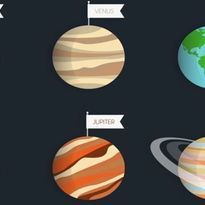In Mosa Mack’s Solar System unit, students are led through a progression of three inquiry lessons that focus on the scale properties of objects in the solar system and how this affects the brightness of stars.
- Lesson 1

Solve: Mars Mystery + Vocabulary Mind Map
Students contextualize Solar System vocabulary in a mind map before helping Mosa Mack come to an aspiring astronaut’s aid in a space-related mystery. Marsha and Wes need to build a canyon contraption to build the first amusement park on Mars, but all his plans are going awry. By the end of The Solve,students discover that the size of surface features of far-away planets, such as canyons, can be determined based on satellite photos and their distance from the Earth. (75 mins)
- Lesson 2

Make: Create a Scaled Space-themed Amusement Park
Students design a space-themed amusement park that is accurately scaled to represent the same dimensions of our solar system and considers scale properties of planets’ features to be represented as park features and attractions. (300 mins)
- Lesson 3

Engineer: Use Scale to create Constellations
Students use their knowledge of scale factors from the Make in order to design an accurate constellation in a box. (300 mins)
